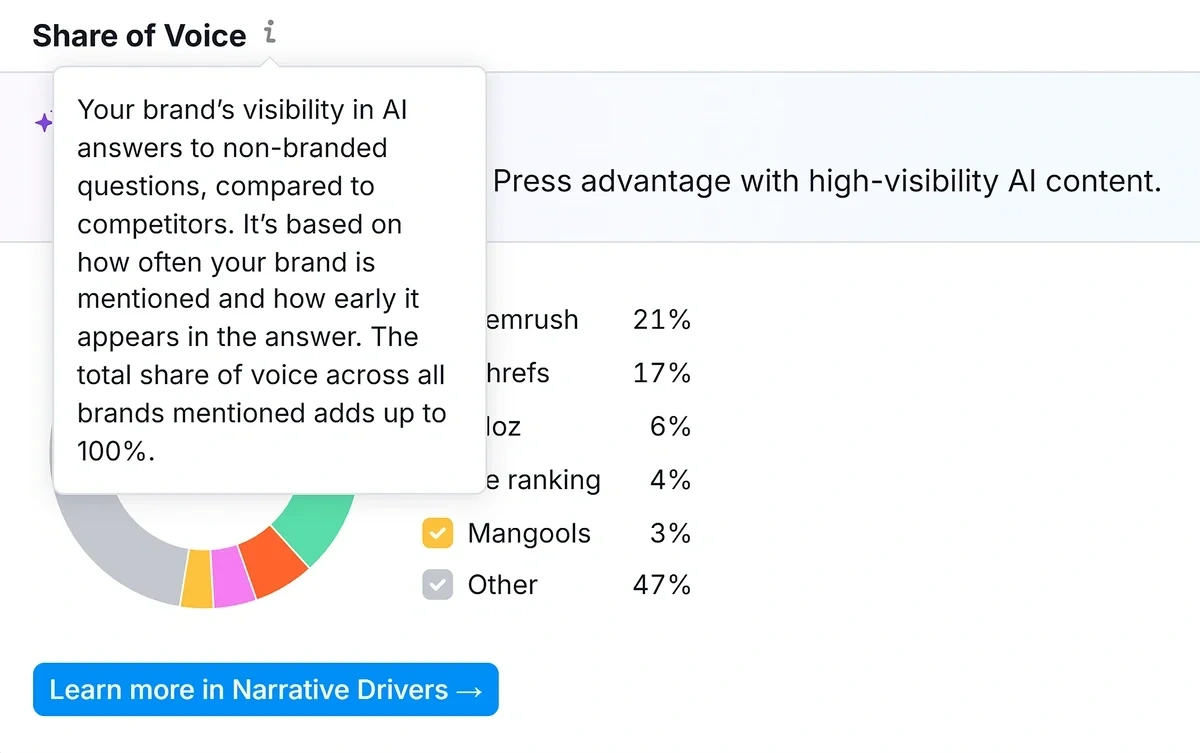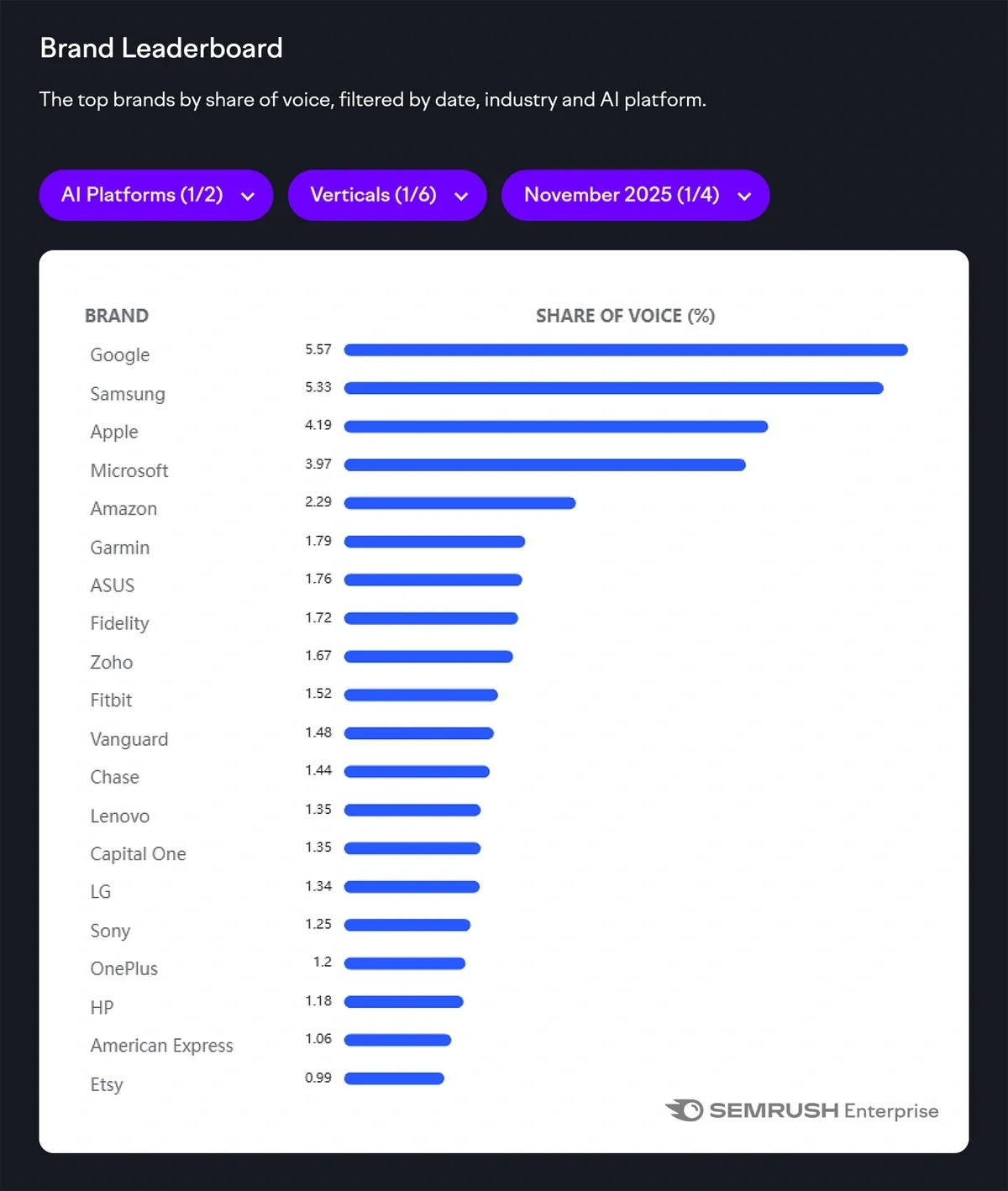
Why AI Share of Voice Matters More Than Your Organic Traffic Numbers
Your organic traffic has decreased since AI Overviews appeared at the top of Google’s search results, and you’re not alone.
Traditional organic search traffic is down across much of the internet as AI-powered search features and platforms deliver answers without the need to click on a website at all.
If you’re concentrating on “fixing” your organic traffic, you may want to reassess your strategy. Sure, organic traffic still matters and it can still drive traffic and conversions, but if you don’t have at least one eye on your AI share of voice, you’re missing a giant opportunity.
Why?
According to Semrush research, AI search visitors are projected to surpass traditional search visitors by early 2028. Some industries may see this tipping point even sooner.
In addition, OpenAI plans to hit 1 billion ChatGPT users by the end of 2025. And according to our most recent ChatGPT data, that’s likely to happen. Perplexity, Claude, and Gemini are all also seeing rapid adoption as people shift how they search for information.
And don’t forget Google’s AI Mode, which completely replaces traditional search results with an AI-generated conversational experience.
By focusing on how often you’re appearing in LLMs (a.k.a. your AI share of voice) now, you’ll be prepared rather than blindsided when your traditional organic traffic keeps declining as more searchers move to LLMs.
What is AI Share of Voice?
AI share of voice measures how often a brand appears in AI-generated search results or conversational responses compared to competitors. It tracks brand visibility in AI-driven platforms like ChatGPT, Gemini, or Perplexity.
The higher your AI share of voice, the stronger your brand presence in AI search results.
In general, the higher your AI share of voice, the more control you have over your brand narrative and industry conversations in general. You want to become the brand AI systems recommend, cite, and mention when users ask questions in your category.
How AI Share of Voice Is Calculated
The simplest formula for AI Share of Voice looks like this:
(Your Brand Mentions / Total Market Mentions) × 100 = AI Share of Voice %
If AI systems mention your brand 25 times out of 100 total brand mentions in your category, you have a 25% share of voice.
But this basic calculation misses something critical: position.
A brand mentioned first in an AI answer carries a lot more weight than one buried at the bottom of a list. A top-of-the-list mention or citation naturally grabs more visibility for your brand than the others.
So in Semrush, for example, you’ll see that share of voice in AI reports is calculated using both frequency and position.
That means that if your brand appeared first in every AI answer you’re mentioned in, you'd achieve 100% share of voice—even if competitors are also mentioned.
This position-weighted measurement gives a more accurate picture of your actual visibility and influence in AI search results.
How AI Share of Voice Differs from Traditional SOV
Traditional share of voice focuses on paid advertising spend, social media mentions, and organic search rankings. You optimize these channels for impressions, clicks, and conversions.
AI share of voice is calculated differently. Instead of always driving users to your website, AI systems gather and parse information and present it directly to users. Your brand gets mentioned, cited, or recommended—often without generating a click to your site.
So, where is AI gathering data and insights about your brand?
There are two AI data source categories:
Discovery sources: User-generated content from Reddit, Quora, review sites, and forums shapes how AI systems perceive your brand. If people are talking about you positively or negatively in these spaces, AI platforms pick up on those signals.
Authority sources: Structured, factual content from your website, Wikipedia entries, press releases, and authoritative publications establishes you as a credible source. AI systems cite these sources when they need trustworthy information.
Winning in AI share of voice requires visibility in both categories. You want people talking positively about your brand AND authoritative content that backs up those conversations.
Speaking of positive mentions, sentiment also matters more in AI search. A negative mention can harm your brand more than no mention at all. AI systems use context and tone to decide how favorable a brand is, meaning reputation management and monitoring your sentiment in LLMs is critical when maintaining your share of voice.
Brands Winning at AI Share of Voice
Which brands can you look at as great examples for how to increase your share of voice across AI platforms?
Let’s take a look at the Semrush AI Visibility Index to find out which brands are dominating AI search across some of the major industries.
HubSpot is near the top of the business and professional services vertical in ChatGPT with 3.3% share of voice. The brand ranks ahead of large competitors like Salesforce and QuickBooks by maintaining a strong presence in both community discussions (a.k.a. discovery sources) and authoritative content.
Zapier shows an interesting split. The brand ranks #1 or #2 depending on the month in Google AI Mode citations within digital technology and software, but it ranks outside of the top 20 brands in mentions.
Why?
Zapier's extensive library of integration guides and tutorials gives it massive authority, but competing brands come up more often in user conversations.
Travel + Leisure, Good Housekeeping, and NerdWallet consistently appear as top-cited domains in Google AI Overviews. These high-authority publishers that perform well in traditional search translate that authority into AI visibility.
What’s really interesting about this data is that fewer than one in five brands are both frequently mentioned and consistently cited as authoritative sources. Most brands excel at one or the other, but not both.
The brands that win AI share of voice are leaders across the full spectrum—from community conversations to authoritative content.
Also, the most recent data shows that the top 50 brands remain relatively stable, but AI search rankings and preferred sources can really shift month to month. So, the broader and more diverse your brand mention ecosystem, the better.
Get a complete view of your competitors to anticipate trends and lead your marketBuild a winning strategy
How to Measure Your AI Share of Voice
You have multiple options for tracking your share of voice in LLMs:
The Manual Method
The simplest way to measure your share of voice costs nothing but time. Simply open ChatGPT, Perplexity, Google AI Mode, or whichever platform you want to measure in. Search questions your target audience might ask about your category.
For example: "What are the best CRM platforms for small businesses?" or "Top marketing automation tools for agencies."
Track how often your brand appears in the responses. Note your position—first, middle, or last. Check if the sentiment is positive, neutral, or negative.
Do this monthly across 20-30 relevant prompts. Calculate your mention percentage compared to total brand mentions. This gives you an imprecise but still insightful sense of your AI visibility.
The downsides of manual measurement, though, are that it's time-consuming, lacks statistical precision, and doesn't scale well for competitive benchmarking.
Semrush AI Visibility Toolkit
The Semrush AI Visibility Toolkit tracks your brand’s visibility (and your competitors’) across multiple AI platforms, including ChatGPT and Google AI Mode.
In the reports, you'll see metrics like share of voice, brand sentiment, number of mentions, and which prompts trigger your brand.
One standout report: Share of Voice vs. Sentiment. This visualization shows you not just how often you're mentioned in comparison to your competitors, but whether those mentions are positive or negative. You also get a tip powered by AI at the top to help you improve your position.
For enterprise businesses, Semrush Enterprise AIO offers even deeper analysis via a larger, more comprehensive dashboard of reports and tools. Track prompts, brands, and overall visibility across even more of the major LLM platforms, including Perplexity, Gemini, Claude, and more.
HubSpot’s AEO Grader
HubSpot's free AEO Grader Tool tracks how frequently ChatGPT, Perplexity, and Gemini cite your brand versus industry competitors. Enter your company, industry, and a few more details and the tool automatically assesses your overall visibility, sentiment, and competitive positioning.
Other Options
AI search monitoring tools like Otterly.ai, Profound, and Scrunch are emerging to provide AI search monitoring for brands. Each takes a slightly different approach to tracking brand mentions across AI platforms.
Need help choosing? Here are our recommendations.
The key is to start measuring now, even if you begin with manual tracking. You can't improve what you don't measure.
How to Improve Your AI Share of Voice
Growing your AI share of voice will require a strategy that addresses growing both the discovery and authority AI source categories.
Here’s how to get started:
1. Build Brand Mentions Across the Web
AI systems learn by finding patterns in vast amounts of online content. The more often your brand appears in relevant discussions, the more likely AI platforms will mention you. Research shows a strong correlation between a brand's popularity—how often it's mentioned and searched by name—and how often it appears in AI search results.
Contribute to Reddit discussions, Quora threads, and industry forums. Focus on providing genuine value rather than promotional content. Craft authentic, helpful responses over obvious marketing content.
Encourage satisfied customers to share their experiences on review sites like G2, Capterra, and Trustpilot. Positive user-generated content signals to AI systems that your brand is worth recommending.
Get featured in industry publications through digital PR outreach. Pitch your brand story, data, or insights to trusted publications in your niche.
2. Create Content for Specific Use Cases
LLMs tend to prefer content tailored to highly specific use cases and audiences. Generic content (think “the ultimate guide to email marketing”) gets ignored.
So, instead of targeting "CRM software," for example, create content like "CRM software for small real estate teams" or "CRMs for accounting firms that integrate with QuickBooks."
These niche topics may have a much lower search volume, but they're exactly what AI surfaces when users ask detailed, conversational questions.
Answer the most specific questions your support team receives. Create product guides tailored to particular verticals. The more granular and helpful your content, the more likely AI systems will cite it.
3. Maintain Consistent Brand Messaging
Sync up any written information about your brand across all touchpoints so that it all effectively says the same thing, in the same way—your website, social profiles, review sites, Reddit mentions, etc. Inconsistent messaging can confuse AI systems about how to accurately represent your brand, leading to less mentions.
Develop clear, consistent language for describing your business's key benefits, target audience, and unique differentiators. Use it everywhere.
LLMs build an understanding of your brand over time. Consistent messaging makes it easier for them to accurately represent you in their responses.
4. Publish Machine-Readable Data
Present information in easily quotable, "chunkable" formats. Use clear headings, bullet points, callouts, and structured content that AI systems can easily parse and cite.
Definitely add schema markup to your website. This is a super important step to help LLMs understand your brand! Use JSON-LD to provide structured data about your organization, products, reviews, and FAQs.
In a nutshell, the easier you make it for AI systems to understand and extract information from your website, the more likely they are to cite you.
5. Monitor and Improve Sentiment
Track not just how often you're mentioned, but how you're mentioned. Negative mentions can actually harm your brand’s LLM visibility more than no mentions at all.
Of course, the occasional less-than-positive mention happens. Address negative reviews and comments quickly. Respond to customer concerns publicly to show you care about resolution. Highlight positive reviews and case studies on your website.
To really dial in positive sentiment, build relationships with industry influencers and thought leaders who can speak positively about your brand in their content.
Finally, add FAQ sections to your website that counter common misconceptions about your product or service. AI often pulls from FAQ content when answering user questions.
6. Optimize for Traditional SEO
Traditional SEO is definitely not dead. In fact, many traditional SEO factors still drive a large portion of brand visibility in LLMs. Publishing helpful content, ensuring your webpages are crawlable, and building brand citations all contribute to AI visibility.
That said, ranking organically in the top positions on Google’s search results pages isn't as crucial for AI visibility as it is for traditional search.
AI systems have a larger pool of content to choose from. They focus on the relevance and quality of discrete "chunks" of content rather than overall page experience like load speeds and content depth. So, content they choose to surface isn’t necessarily also the top-ranked content in Google search.
Start Tracking Your AI Share of Voice Now
To gain visibility today and invest in the future, it’s important to start work on your AI search optimization plan now.
LLMs learn by finding patterns in vast amounts of online content. If you can influence and shape these patterns now, your brand will be surfaced more frequently, accurately, and favorably as AI search continues to grow in popularity.
So, start measuring your AI visibility today. Identify where your competitors are outperforming you. Create a strategy to build up both your discovery sources and your authority sources.
Establish your baseline and track your progress with tools like the Semrush AI Visibility Toolkit. Monitor your share of voice, sentiment, and competitive positioning in the top AI platforms as you work to build your brand.
My advice: don’t wait on this one. LLM visibility is important and timely enough to really lean in to starting now.
Stop Guessing, Start Growing 🚀
Use real-time topic data to create content that resonates and brings results.
Exploding Topics is owned by Semrush. Our mission is to provide accurate data and expert insights on emerging trends. Unless otherwise noted, this page’s content was written by either an employee or a paid contractor of Semrush Inc.
Share
Newsletter Signup
By clicking “Subscribe” you agree to Semrush Privacy Policy and consent to Semrush using your contact data for newsletter purposes
Written By


Jolissa Skow is a senior content writer and content strategist with a background in SEO, Google Analytics, and WordPress. She's be... Read more





